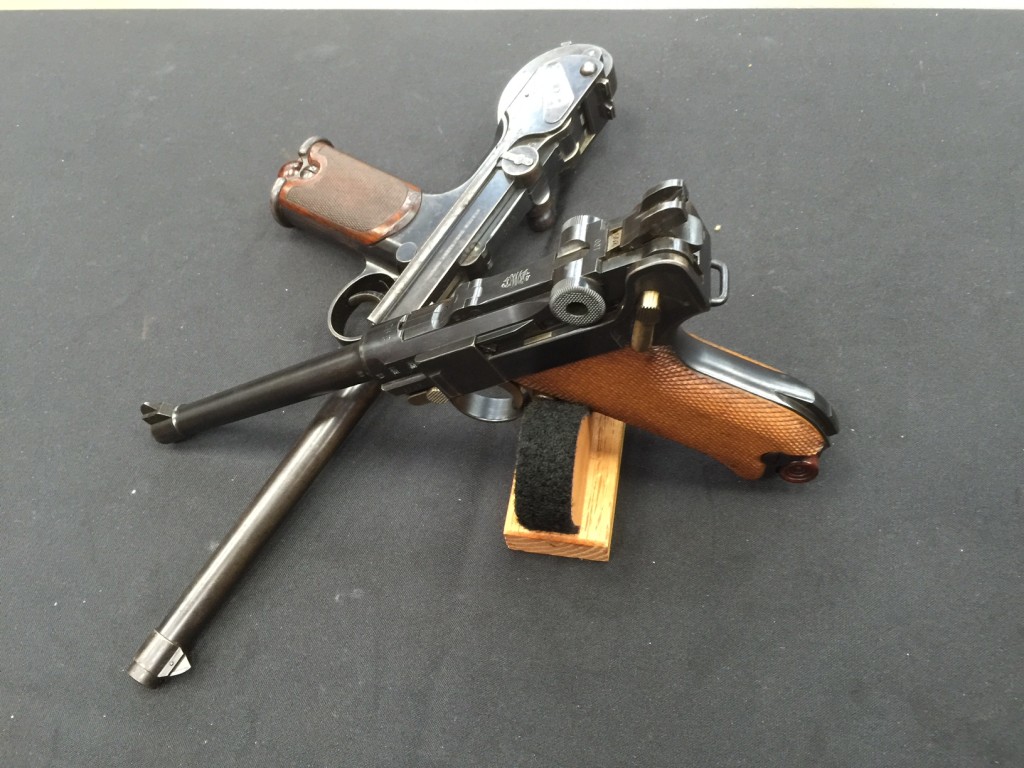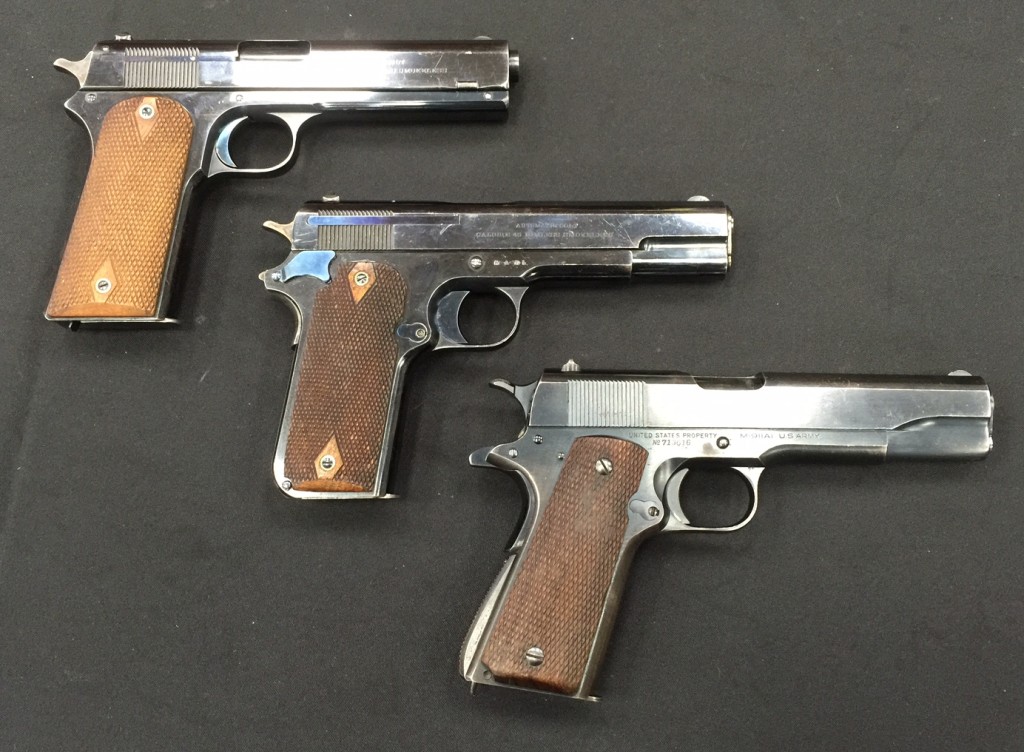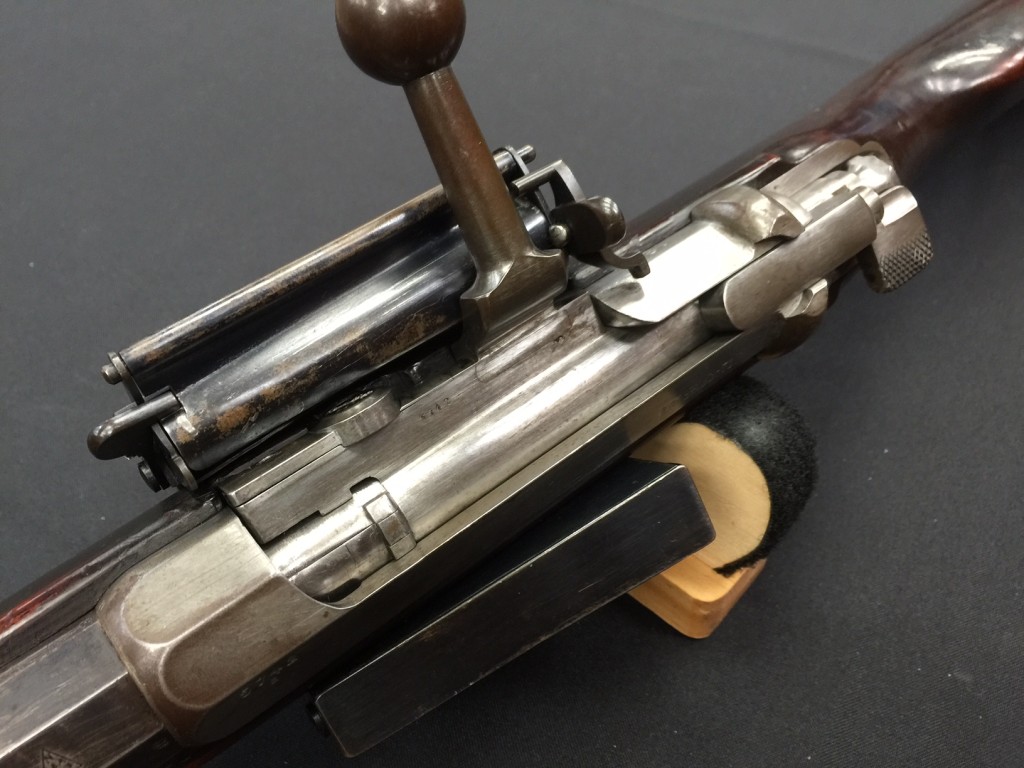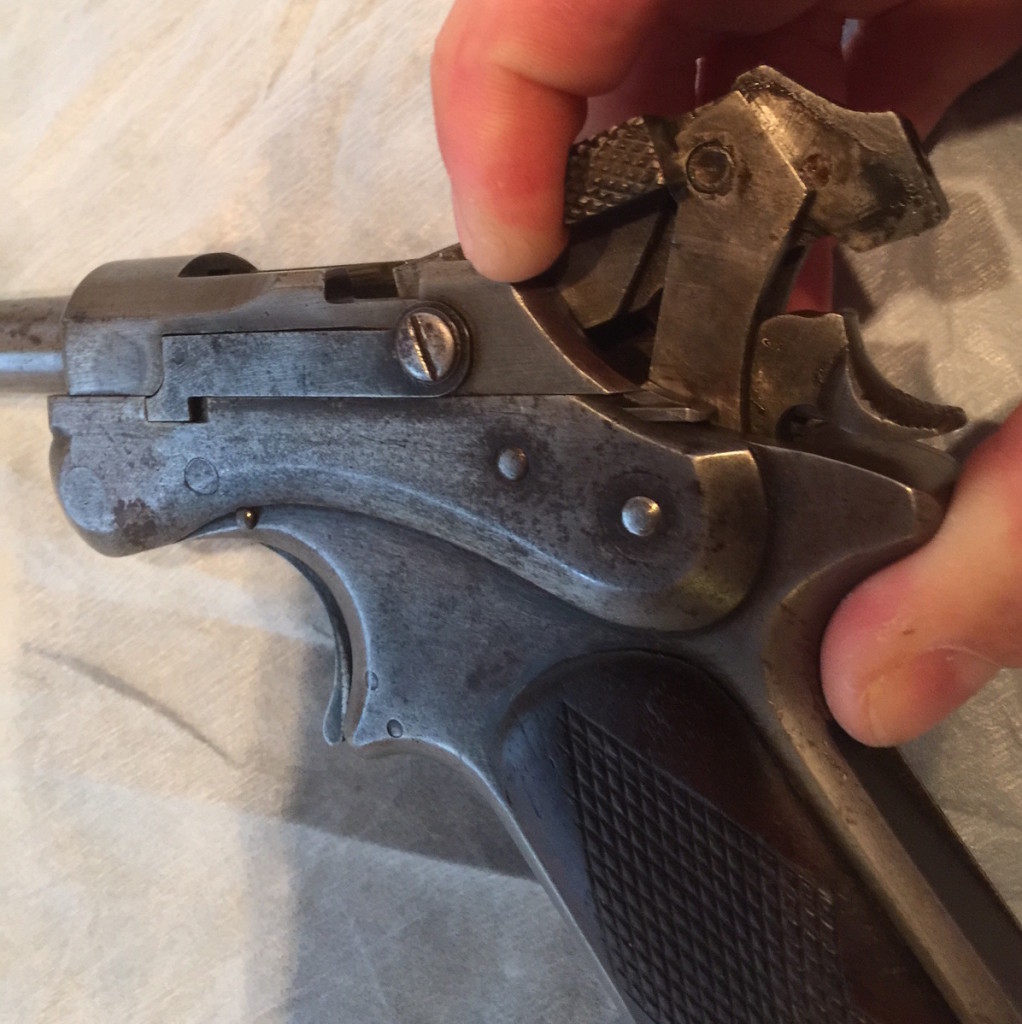Sorry guys – I’m sorting myself out after a week on the road and I don’t have a real post lined up for today. Instead, I will just tease you with some of the videos I have just finished filming, and which will be publishing (along with much more!) in the coming weeks…






the Knoble really looks like something I’d be interested in.
I sense a theme here though: development.
In the first photo we have a Borchardt, and the Luger it inspired, a set of prototype rifles ready for a trial, the evolution of the M1911, an experimental upgrade for the Gewehr 71, and what looks at first glance like an experimental, proof of concept handgun.
For me: this is set of WHAT-IF in fire-arm development
1. What if Kniegelenkverschluss like in Luger automatic pistol (and Maxim machine gun) would become standard in automatic pistols? Additionally: what if bare barrel aesthetic would win slide cover aesthetic? How would modern automatic pistols looks like (similar to Webley-Scott? Lahti L-35?)
2. Assume that US forces adopted Browning design before 1911, then it looks like pistol of upper or middle part of this photo
3. Alternative to real-world Gewehr 71/84
4. Knoble automatic pistol was one of contenders in 1907 US Pistol & Revolver Trials, which has impact on further development of automatic pistols. What if result of this trials would be other than in real-word?
personally I prefer the exposed barrels, but then, according to people around me, I’m weird. I like your thought as well, I have a couple of “What Ifs” I like to think about, so to see someone actually put in the time to research and examine them, would be awesome
This would also make the gun less muzzle-heavy than the Browning’s designs (inclusive of tokarev). On the other hand, exposed barrels would also expose the mechanism to e.g. mud in the trenches of the Great War.
Andrzej
Having never seen a Knoble “open” before, I’m interested to learn that it has a toggle-lock breech along Maxim or Borchardt lines. Now the profile of the one entered in the 1910 U.S. Army trials makes sense. Even though, according to the Ordnance Board, it was too crudely machined to operate reliably.
The “revolver barrel” design came about because it tends to give the autopistol the same weight and balance distribution as… a revolver. Keep in mind that at the time, the primary military mode of pistol use was still one-handed, on horseback. In such a stance, the “revolver barrel” gun is light and extremely fast to handle, especially when engaging multiple targets.
The Browning type, by comparison, is a bit steadier in deliberate fire due to having a bit more weight up front. You may have noticed that most .22 target pistols, especially those in .22 Short for Olympic rapid-fire events, have “light” barrels- with weights bolted on underneath them for more weight up front. SIG seems to have been the first manufacturer to realize the innate silliness of this, resulting in the P240 target automatic;
http://picturearchive.gunauction.com/573/9885549/img_5144.jpg_thumbnail1.jpg
Colt came close with the Gold Cup National Match in .38 Spl MRWC;
http://collectorebooks.com/gregg01/coltpistol/DSC06799.jpg
But showed the fundamental illogic of the usual design with the Match Target Woodsman;
https://c1.staticflickr.com/3/2656/4182806583_9a2df270ed.jpg
It was developed after target shooters raised “issues” with the original;
http://www.coltautos.com/woodsmans/1Series/1stBullseyeMT9655.jpg
Which seemed better suited to woods-loafing than winning gold medals.
Light vs. heavy barrel. Which you choose depends on the objective and your technique.
And what you’re sitting or standing upon.
cheers
eon
“SIG seems to have been the first manufacturer to realize the innate silliness of this, resulting in the P240 target automatic”
Russian ИЖ-ХР-30 (for .22 rim-fire) was earlier target automatic pistol with covered barrel: http://infogun.ru/index.php?mod=enc&enc_id=190 (production started 1970)
Which is better for balancing the acts of hitting bull’s eyes in a competition and downing “Table-Top RPG” monsters that suddenly pop out of the background of said competition range?
1. Gewehr 88 (free floating barrel and stopping power)
2. CZ 75 (the original Wonder Nine or I could be wrong)
3. Ross Rifle in .280 Ross
4. Lebel-Grasset (the Nitro Express variant of the Lebel)
5. Civil War era Whitworth Rifle with polygonal rifling and proprietary ammunition (Poor Sedgwick!)
6. K31 loaded with proper 7.5×55 GP 11
7. M91 Carcano
8. Type 92 Heavy Machine Gun
9. 8.8 cm PaK 43/41
10. Or per the usual, screw the budget and add your favorite toys to this list
Answering the question is totally voluntary. Please, don’t flak me for it.
Thank you,
Cherndog
I would like to say Ross, but screw it, I’ll take a flak 88
after all, nuking them from orbit is the only way to be sure.
The Whitworth is ruled out because it takes a week to reload the d***ed thing between shots. (Scrub out barrel, patch hexagonal “bolt”, ram slowly, etc.)
The Flak 36 is a bit lacking in RoF for close-in work, as well.
Barring a Gepard FlakPanzer or a T-30M Tunguska, I’d go for an M16 half-track quad .50. Or else an M163 Vulcan 20mm SP mount (on M-113).
Never bring a pistol to a rifle fight.
Never bring a rifle to a surface gun action.
cheers
eon
If you want to get high RoF and have polygonal rifling then choice is Rikhter R-23 autocannon, it is unique revolver canon able to fire 2500 rpm.
Considering “revolver” barrel for automatic pistol: notice that it allow usage of different barrel length without breaking aesthetic (see Luger and Artillerie Luger) like in revolver – typically one model of revolver can be found in variants with different barrel lengths (at least in case of first half of 20th century US revolver, I’m not expert in later designs) – see for example S&W Military & Police (not to be confused with S&W M&P automatic pistol) which can be found with 2″, 3″, 4″, 5″ or 6″ barrel.
If you need fire-arm which would be accurate and dealing a punch at one time answer is: .375 H&H Magnum, the first cartridge to be named Magnum (Latin: large/great/powerful/big) in bolt-action rifle (Winchester Model 70 for example)
Did you already published your video about TT33?
Dear Ian,
I was up at Leeds today checking on the Mendoza LMG.
The bolt turns about 35/40 degrees and there are in effect six
locking surfaces that have to touch at the same time,this is
not easy to achieve with the machines available at that time
(1948)
Interesting…
One would have used a standard gear hobber to do it. While these a specialized milling machine, they were and still are used in very large numbers.
It’s just one of those machines that we don’t tend to buy and keep in a home workshop. A few years ago I did look into buying one, but decided that when factoring in time, space and money that my curiosity would be satisfied well enough by a visit to a gear making job shop.
As Ian said, that’s interesting. I wonder whether the Mendoza LMG was considered ‘complex’ to manufacture by Spanish technicians (numbers of the C-1934 version found their way to Republican Spain during the Civil War). Anyway, after the war the new Francoist army must have found it good enough for they published a full manual for the C-1934. Despite that, the chats at the Oviedo arsenal preferred to copy the ZB.30 instead. Wise move, me thinks.
Hmm… [looks at the White rifles] I want them, but they’re likely too expensive for me. DARN IT ALL!!!!
Is this stuff from RIA’s online-only auction next week? I’m eyeing a few of the less expensive-looking things in that catalog…
Oh wow, White rifles. Now THOSE I’m interested in.
Think you will be able to take one apart?
Unfortunately, I was not able to disassemble them.
did you get to take the Knoble apart by any chance?
Hmmm, that is really unfortunate! The White rifles are the most exciting stuff hinted above, imho.
Funny that a Colt 1905 showed up, I was reading about a murder case in San Antonio from 1909 and the person who stood trial was accused of killing the other person with a Colt 1905. Wasn’t the sort of gun one would expect to find in San Antonio just after the wild west days. The accused was a railway engineer turned lawyer (stranger things have happened) who seems to have been mechanically inclined.
The early autopistols were more popular “out West” than you might think. I have books with several photographs of Westerners of that time with M1900 Parabellums, early Colts, and even Mauser C/96s.
A large number of marshals, sheriffs and Texas Rangers went straight from the Colt Peacemaker to the 1911, bypassing the New Service DA revolver completely. (They considered the .38 Army Special aka Official Police a “mouse gun”.)
The main reason (besides it being a .45) was that they were used to the short, relatively light single-action trigger of the Peacemaker, which the 1911 pretty much duplicated.
Most such pistoleers didn’t carry the 1911 in the modern Condition One “cocked and locked” mode; they carried it hammer down on a loaded chamber and thumb-cocked it on the draw, just as they were used to doing with the Peacemaker.
That’s why to this day Condition Two (hammer down on a loaded chamber) is also known as the “Mexican Carry” or the “Border Carry”. It’s older than even most shooters realize.
cheers
eon
Eon
When I owned and carried a Springfield mil.spec. I use to carry it on a loaded chamber hammer on half cock. This method locks the trigger and the slide. This method works best for me and it works well for my TT33 also.
That is interesting. The accused (in the 1909 San Antonio murder case) had also patented a new pump design, and I had thought that maybe he just liked mechanical curiosities. The accused was acquitted 2 years later, and ended up spending the last 13 years of his life looking in vain for the treasure from an old Spanish legend before he was found burned to death in 1943. The 1905 had 7 cartridges in it. The accused stated that he only kept 7 in it. The attending doctors thought the victim had been shot twice, so maybe he was innocent. It would have been easier for him to have gotten off if he had had a revolver–it would have been obvious if a cartridge had been fired or not (he was taken into custody immediately after the incident).
Coincidently, Jeff Cooper went from a Peacemaker (he used one in WWII) to a 1911 himself. There is a photo of an early match in California with Jack Weaver making use of the “Weaver” stance, while Cooper was next to him hip shooting with a Peacemaker–how times changed.